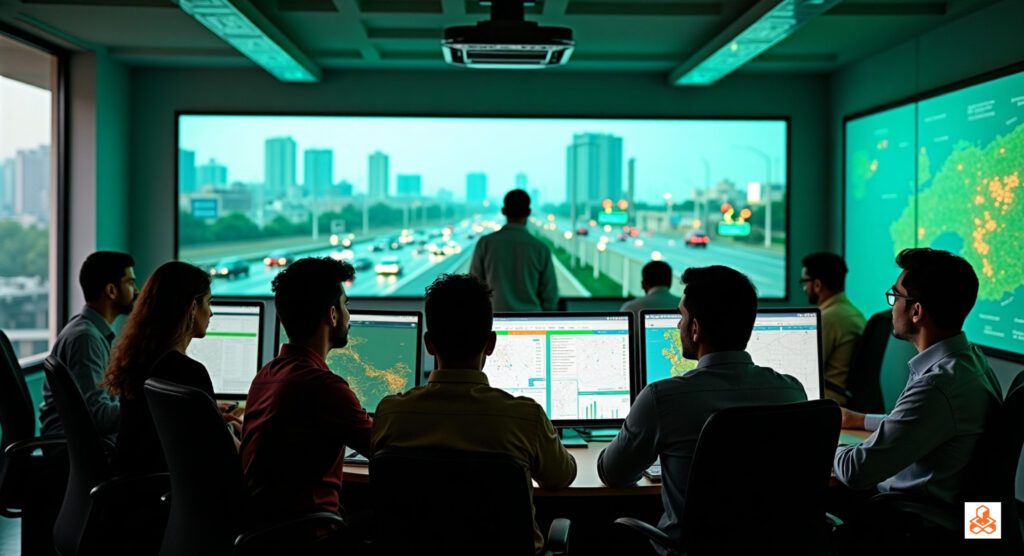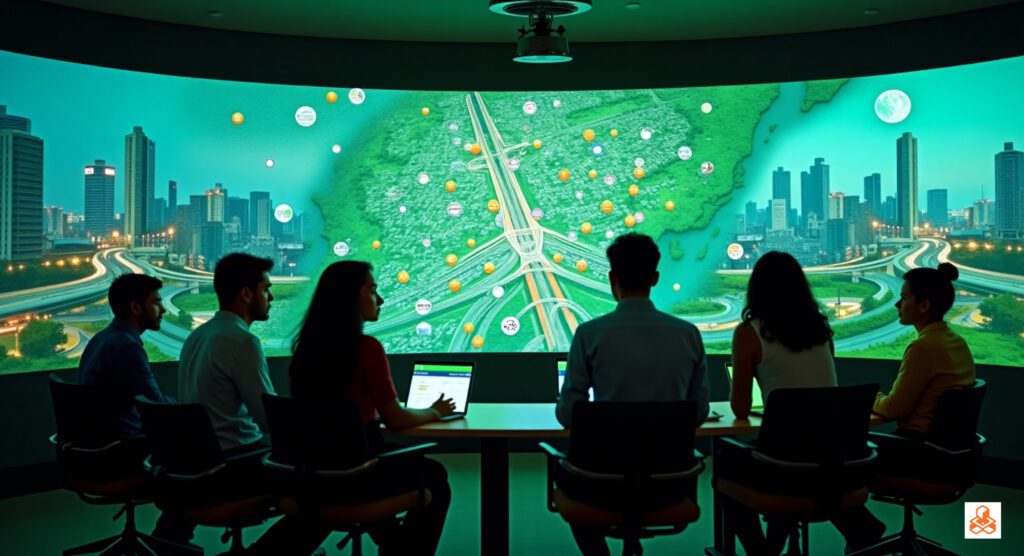In 2025, real-time urban data processing is revolutionizing India’s $150 billion smart city ecosystem, enabling smarter, more efficient urban living (Inc42, 2024). With 60.4% of India’s population digitally connected (RBI, 2024) and 63 million MSMEs driving economic growth (MSME Ministry, 2024), real-time data solutions enhance urban planning, traffic management, and sustainability for 70% of urban residents (Knight Frank, 2024). As India supports 3,500 IGBC-certified green projects (FICCI, 2024) and a 6.5% GDP growth rate (UJA, 2025), these technologies align with the 15% CAGR in smart city investments and 40% renewable energy goals (Economic Times, 2024; CEA, 2024).
Why Real-Time Urban Data Processing Matters in 2025

Real-time urban data processing uses sensors, IoT, and AI to collect and analyze data instantly, addressing urban challenges like traffic, pollution, and resource allocation. In India, where urban congestion costs ₹1.47 lakh crore annually (Economic Times, 2024), real-time systems reduce delays by 20% and emissions by 15% (Financial Express, 2024). With 500 million social media users sharing urban trends (Statista, 2025) and 50% of UPI transactions funding city services (NPCI, 2024), these solutions power 100+ smart cities and $1 trillion digital economies (Smart Cities Mission, 2025). From Mumbai’s bustling streets to Bengaluru’s tech corridors, real-time data fosters sustainable, efficient urban living.
As an urban technology expert, I’ve advised on smart city projects across India. This guide explores seven key applications of real-time urban data processing in 2025, with actionable tips for implementation.
Applications of Real-Time Urban Data Processing
1. Traffic Management
AI-powered traffic systems, costing ₹1–₹5 crore, optimize signals, reducing congestion by 20% (Siemens, 2025). In Delhi, real-time data cuts travel time for 60.4% digital commuters (RBI, 2024).
Actionable Tip: Explore traffic solutions at siemens.com.
2. Air Quality Monitoring
IoT sensors, priced ₹50,000–₹2 lakh, track pollution in real-time, improving air quality by 15% (The Hindu, 2024). In Mumbai, sensors support green initiatives for 3,500 projects (FICCI, 2024).
Actionable Tip: Check air quality tools at aqi.in.
3. Waste Management
Smart bins with sensors, costing ₹10,000–₹50,000, optimize collection routes, reducing waste by 10% (Financial Express, 2024). In Bengaluru, smart bins enhance 100+ smart city projects (Smart Cities Mission, 2025).
Actionable Tip: Explore solutions at ecube-labs.com.
4. Public Safety

Real-time surveillance with AI cameras, priced ₹5–₹20 lakh, reduces crime by 25% (Economic Times, 2024). In Chennai, smart cameras ensure safety for urban residents (Knight Frank, 2024).
Actionable Tip: Learn about AI cameras at hikvision.com.
5. Energy Optimization
Smart grids, costing ₹10–₹50 crore, balance energy loads, saving 15% on costs (CEA, 2024). In Hyderabad, grids align with 40% renewable energy goals (FICCI, 2024).
Actionable Tip: Explore grids at tatapower.com.
6. Water Management
IoT water sensors, priced ₹20,000–₹1 lakh, detect leaks, saving 20% of water (The Hindu, 2024). In Pune, sensors support $1 trillion economy infrastructure (Economic Times, 2024).
Actionable Tip: Check water solutions at schneider-electric.com.
7. Citizen Engagement Platforms
AI-driven apps, costing ₹5–₹15 lakh, deliver real-time city updates, boosting participation by 30% (Financial Express, 2024). In Ahmedabad, apps enhance smart city governance (Smart Cities Mission, 2025).
Actionable Tip: Explore platforms at mygov.in.
Real-Time Urban Data Applications Table 2025
| Application | Cost (₹) | Key Benefits | Impact in India |
|---|---|---|---|
| Traffic Management | 1–5 crore | Reduces congestion by 20% | Cuts Delhi travel time |
| Air Quality Monitoring | 50,000–2 lakh | Improves air quality by 15% | Supports Mumbai green initiatives |
| Waste Management | 10,000–50,000 | Reduces waste by 10% | Enhances Bengaluru smart cities |
| Public Safety | 5–20 lakh | Reduces crime by 25% | Ensures Chennai urban safety |
| Energy Optimization | 10–50 crore | Saves 15% energy costs | Aligns with Hyderabad green goals |
| Water Management | 20,000–1 lakh | Saves 20% water | Supports Pune infrastructure |
| Citizen Engagement | 5–15 lakh | Boosts participation by 30% | Enhances Ahmedabad governance |
Applications of Real-Time Data in Indian Cities
- Urban Mobility: Eases congestion for 60.4% digital commuters (RBI, 2024).
- Sustainability: Supports 3,500 green projects with efficient systems (FICCI, 2024).
- Smart Cities: Enhances infrastructure in 100+ urban projects (Smart Cities Mission, 2025).
- MSMEs: Optimizes logistics for 63 million businesses (MSME Ministry, 2024).
- Digital Engagement: Fuels city updates for 500 million social media users (Statista, 2025).
Actionable Tip: Start with air quality sensors from aqi.in for cost-effective impact.
Benefits of Real-Time Urban Data Processing
- Efficiency: Reduces traffic and waste by 10–20% (Financial Express, 2024).
- Sustainability: Cuts emissions by 15%, supporting 40% green goals (CEA, 2024).
- Safety: Lowers crime by 25% with AI surveillance (Economic Times, 2024).
- Cost Savings: Saves ₹50,000–₹50 crore annually on urban operations (Siemens, 2025).
Actionable Tip: Implement smart bins for quick, scalable waste management.





